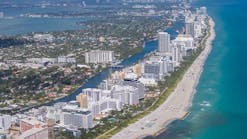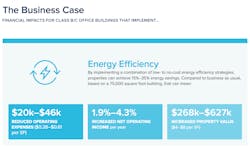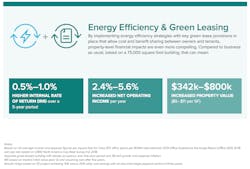Since our firm does work in both the new construction and existing building spaces, we have long known that convincing the owners of older buildings to implement energy efficiency improvements – even when there is a compelling ROI – can be an uphill struggle. There is a strong business case for making older buildings more sustainable, and educating owners and managers is essential to having that happen.
On that note, a colleague of mine on the BOMA Florida energy committee, recently had the opportunity to provide input to a joint Rocky Mountain Institute/ULI/BOMA International article entitled “Unlocking Hidden Value in Class B/C Office Buildings”. For those not familiar with the terminology, very simply, Class B buildings generally provide economical office space by sacrificing certain amenities, rather than functionality. They tend to be smaller and somewhat older buildings, but may have at one time been Class A (top-of-the-line) space. Class C office buildings are older and often less attractive, and have minimal amenities. They do, however, have the lowest rental rates of purpose-built office buildings.
Since Class B/C buildings do not garner high rent rates and, because they are older, frequently have higher maintenance costs, it is difficult to convince those owners to invest in green improvements. Even energy efficiency – such as an LED lighting retrofit – that often has a simple payback period of three years or less, is often a difficult obstacle to overcome. According to the RMLI/ULI/BOMA article, the reasons cited for not implementing energy efficiency improvements, by the stakeholders that they surveyed, were “limited working capital to pay for project costs (60 percent), limited staff capacity to implement (47 percent), and low priority versus other business activities (40 percent)”.
According to the RMLI/ULI/BOMA study, Class B/C buildings could save approximately 15 percent of their energy costs by implementing low and no-cost energy efficiency improvements. With even modest capital investment, the increased savings can still result in a simple payback period of three years. In addition to reduced operating expenses, these savings translate to increased net operating income (NOI), increased property value, and justification for increased rent rates.
If commercial PACE (C-PACE) is available and utilized to finance the improvements, the cost of repayment may qualify as a CAM (Common Area Maintenance Expenses) pass-through. C-PACE, about which I’ve frequently written, is Property Assessed Clean Energy for commercial buildings. It is a financing mechanism that enables long-term funding for energy efficiency, renewable energy, and in some localities, water conservation, hurricane hardening (Florida), and seismic strengthening (California) projects. PACE financing is securitized by a special non-ad valorem tax assessment on the property, and is repaid as part of the property’s regular tax bill.
PACE-enabling legislation has been passed in 36 states and the District of Columbia; to learn if there is an active program in your area, go to https://pacenation.org/pace-programs/.
It is unfortunate that Class B/C buildings are substantially behind their Class A counterparts in taking advantage of the benefits of energy efficiency improvements, since they have the most to gain. Educating owners (along with pressure by tenants, as they become more aware of the need to be green in order to meet their customer’s expectations), and the decreasing costs of improvements as technology improves, will hopefully encourage Class B and C buildings to become more energy efficient.
A regular contributor to HPAC Engineering and a member of its editorial advisory board, Larry Clark is a principal at Sustainable Performance Solutions LLC, a south Florida-based engineering firm focusing on energy and sustainability.










